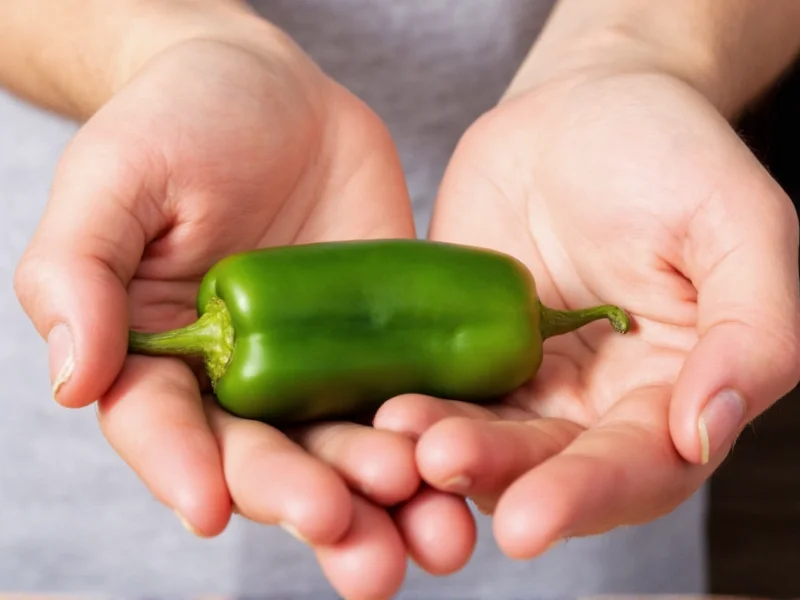When you've been handling jalapeño peppers, that burning sensation on your hands isn't just uncomfortable—it's your skin reacting to capsaicin, the oily compound that gives peppers their heat. Water alone won't help because capsaicin is oil-based and hydrophobic. Understanding the chemistry behind the burn is key to finding effective solutions that actually work.
Why Jalapeño Causes Burning and Why Water Doesn't Help
Capsaicin, the active component in jalapeños and other chili peppers, is a lipophilic compound, meaning it binds to fats and oils rather than water. This explains why rinsing with water often seems to make the burning sensation worse—it can spread the oil while doing little to dissolve it. The compound triggers TRPV1 receptors in your skin, which normally respond to heat, creating that familiar burning feeling.
Most Effective Methods for Removing Jalapeño Residue
Successful removal requires substances that can dissolve or neutralize the capsaicin oil. Here are the most scientifically supported approaches, ranked by effectiveness:
| Method | Effectiveness | Time Required | Items Needed |
|---|---|---|---|
| Oil + Soap Wash | ★★★★★ | 3-5 minutes | Cooking oil, soap, warm water |
| Dairy Soak | ★★★★☆ | 5-10 minutes | Milk, yogurt, or sour cream |
| Alcohol Treatment | ★★★★☆ | 2-4 minutes | Hand sanitizer or rubbing alcohol |
| Baking Soda Paste | ★★★☆☆ | 5-7 minutes | Baking soda, water |
Oil-Based Removal Technique (Most Effective)
This method works because "like dissolves like"—oil dissolves the capsaicin oil. First, pour a small amount of vegetable oil, olive oil, or even peanut butter onto your hands. Massage it thoroughly into the affected areas for 30-60 seconds. The oil will help break down the capsaicin compounds. Then, wash your hands thoroughly with soap and warm water. Repeat if necessary. This two-step process (oil first, then soap) is significantly more effective than soap alone for how to get jalapeno off hands completely.
Dairy Products for Capsaicin Neutralization
Milk, yogurt, or sour cream contain casein, a protein that binds to capsaicin and helps wash it away. Soak your hands in cold milk for 5-10 minutes, or apply plain yogurt directly to the affected areas. The fat content in dairy also helps dissolve the oily capsaicin. This method works particularly well for those seeking natural remedies for jalapeno pepper hands remedy without harsh chemicals.
Alcohol-Based Solutions
Rubbing alcohol (isopropyl alcohol) or alcohol-based hand sanitizer can effectively dissolve capsaicin. Apply a generous amount to your hands and rub thoroughly for 30 seconds before washing with soap and water. The alcohol breaks down the oil-based capsaicin, making it easier to wash away. This is one of the quickest methods for how to stop jalapeno hands burning when you need immediate relief.
Alternative Methods When Standard Solutions Aren't Available
If you don't have oil, dairy, or alcohol immediately accessible, these alternative approaches can provide some relief:
Baking Soda Paste
Create a paste with baking soda and water (use a 3:1 ratio of baking soda to water). Apply to affected areas and gently rub for 1-2 minutes before rinsing. Baking soda's mild abrasiveness helps remove the oil while its alkaline properties can neutralize some of the capsaicin. While not as effective as oil-based methods, it's a good household solution for how to remove jalapeno burn from hands.
Vinegar Solution
Mix equal parts white vinegar and water. Soak a cloth in the solution and wipe your hands thoroughly. The acidity can help break down capsaicin to some extent. Vinegar works better as a preventive measure—soaking your hands in vinegar before handling peppers can create a protective barrier.
What NOT to Do When Handling Jalapeño Residue
Certain common approaches can actually worsen the problem when trying to get rid of jalapeno residue:
- Rubbing with just water - Spreads the oil without removing it
- Using hot water - Opens pores and can increase absorption of capsaicin
- Touching your face or eyes - Transfers capsaicin to sensitive areas
- Using harsh chemicals - Can damage skin barrier while not effectively removing capsaicin
Prevention Tips for Future Pepper Handling
The best approach for jalapeno hands burning is prevention:
- Wear disposable nitrile gloves (latex isn't as effective against oils)
- Apply a thin layer of cooking oil to hands before handling peppers
- Use a dedicated cutting board for spicy peppers
- Wash knives, cutting boards, and surfaces with soapy water immediately after use
- Consider using pepper corers that minimize direct contact
When to Seek Medical Attention
While jalapeño burns are usually temporary, seek medical help if you experience:
- Severe blistering or skin damage
- Prolonged burning lasting more than 24 hours
- Signs of infection (increased redness, swelling, pus)
- Accidental transfer to eyes causing persistent pain











 浙公网安备
33010002000092号
浙公网安备
33010002000092号 浙B2-20120091-4
浙B2-20120091-4